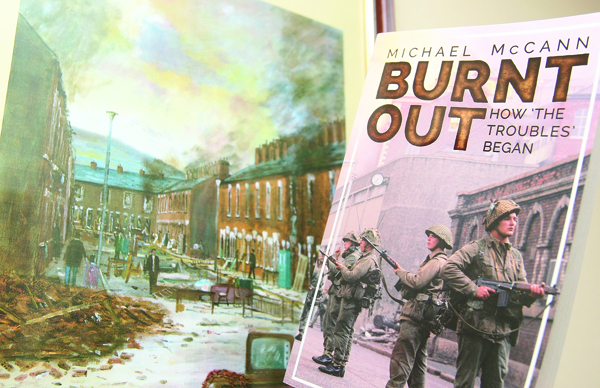A groundbreaking new book that documents crucial personal testimonies of the pogroms of 1969 is to be officially launched at Cultúrlann McAdam Ó Fiaich next week.
Written by Dermott Hill man, Michael McCann, ‘Burnt Out – How the Troubles Began’ is a fascinating account of how thousands of nationalist and Catholic families were forced from their homes during the onset of our recent conflict.
Michael McCann and his family were themselves forced from their North Howard Street home during that summer, which would go on to change the course of history.
The book is a product of 10 years of research, using eyewitness accounts and archival evidence of the violence that displaced almost 2,000 Belfast families.
Despite the significance of the events, Michael said the nationalist narrative of the events of 1969 had largely been written out of the history books, inspiring him to begin his research.
“I looked at the history books and there was nothing there,” he explained.
“Fifty years after the event if you lift a book from Queen’s History Department, a few miles from the epicentre of Divis Street, there is nothing. Anywhere else there is nothing. While the 30 years of violence was going on acadamia was part of the British establishment. Why would they regard state and loyalist violence? That’s why I started doing this research.
“There have certainly been a handful of books, there’s ‘Ardoyne – The Untold Truth’ and they give a slight bit about it, and there’s a few small booklets on Bombay Street, but there’s not much else.
“There’s literally no nationalist narrative of this story at all. August 1969 was totally written out. Some revisionist historians have attempted to put the blame of the conflict on the IRA who were virtually non-existent at the time. The IRA were virtually going off the stage.
“This was a planned pogrom by loyalists. The police came and fired thousands of shots and created a bridgehead for the loyalists to come down into every street and throw petrol bombs. Eyewitness accounts have personal experience of this.”
Michael’s account is framed in the context of a state formed on sectarianism. That sectarianism would go on to rip the North of Ireland apart and would, ultimately, distort official histories of the conflict. However, Michael said the eyewitness accounts of those who suffered the violence are bolstered by impartial archival evidence and a crucial testimony from English journalist, Max Hastings.
“His evidence is key to this,” he said.
“Max Hasting’s walked into Patrick Rooney’s [Divis] flat, a nine-year-old boy who was shot when an armoured car with 30 millimetre browning machine guns opened up on houses and flats. He was on the scene and witnessed the shooting. He saw the father with the child in his arms and he said the room was ‘covered in matter’.
“He then went on and witnessed the other violence in the streets. His evidence is key to this.”
‘Burnt Out’ is a crucial account of the pogroms that brings previously unheard voices to the fore and gives an historiographically fuller picture of early days of the conflict. While absolutely crucial to understanding The Troubles, Michael said those voices could easily have been lost to time.
“Many of the people who I spoke to are dead,” he explained.
“A lot of those accounts would have been lost if I hadn’t started my research when I did.
“There have been massive gaps in the history of the Troubles. I think it will change people’s understanding of why things happened. Violence didn’t come out of nowhere – 1,820 families didn’t just leave their home for nothing.”
‘Burnt Out’ will be launched at Cultúrlann McAdam Ó Fiaich in February 21 at 7pm.






